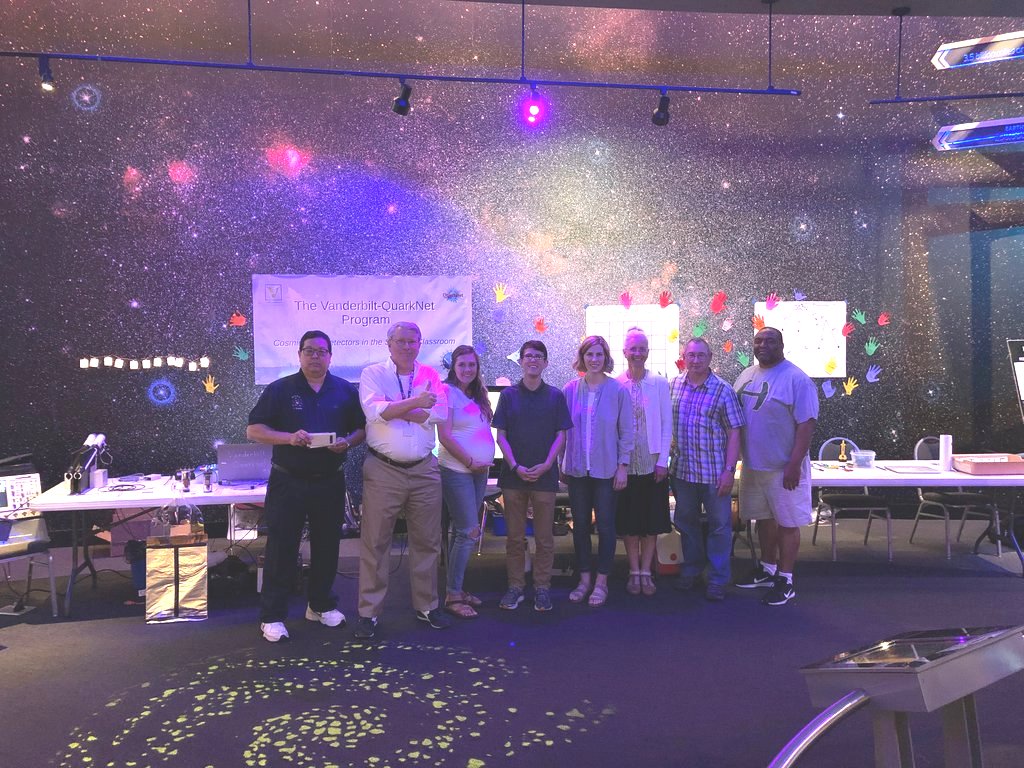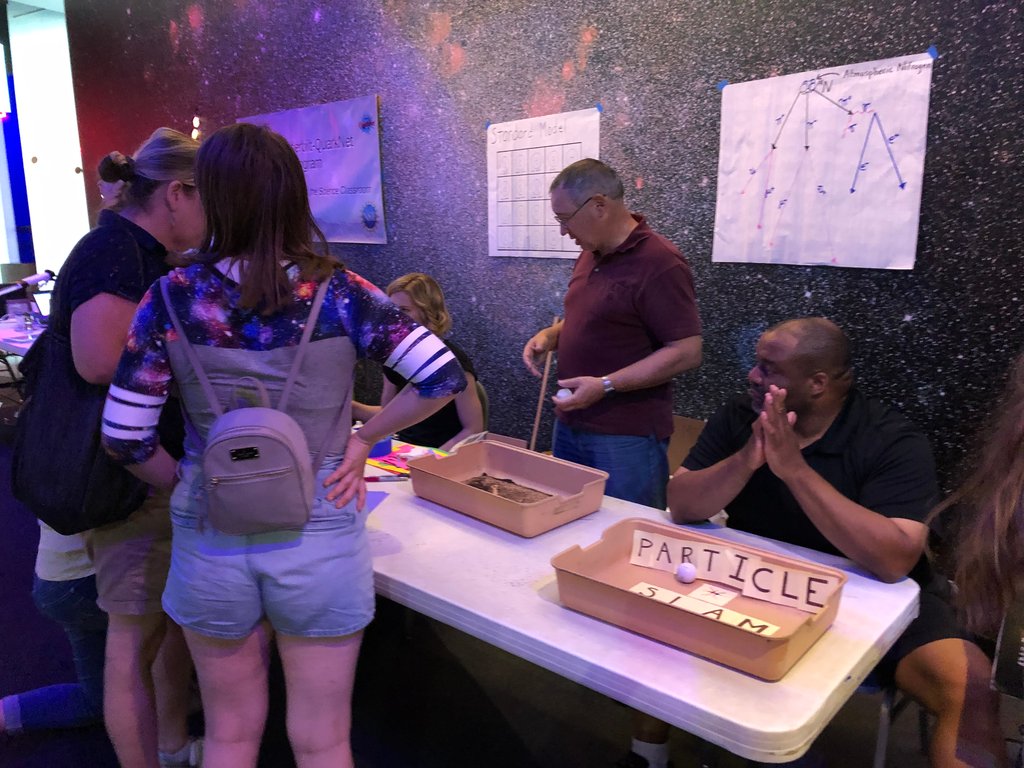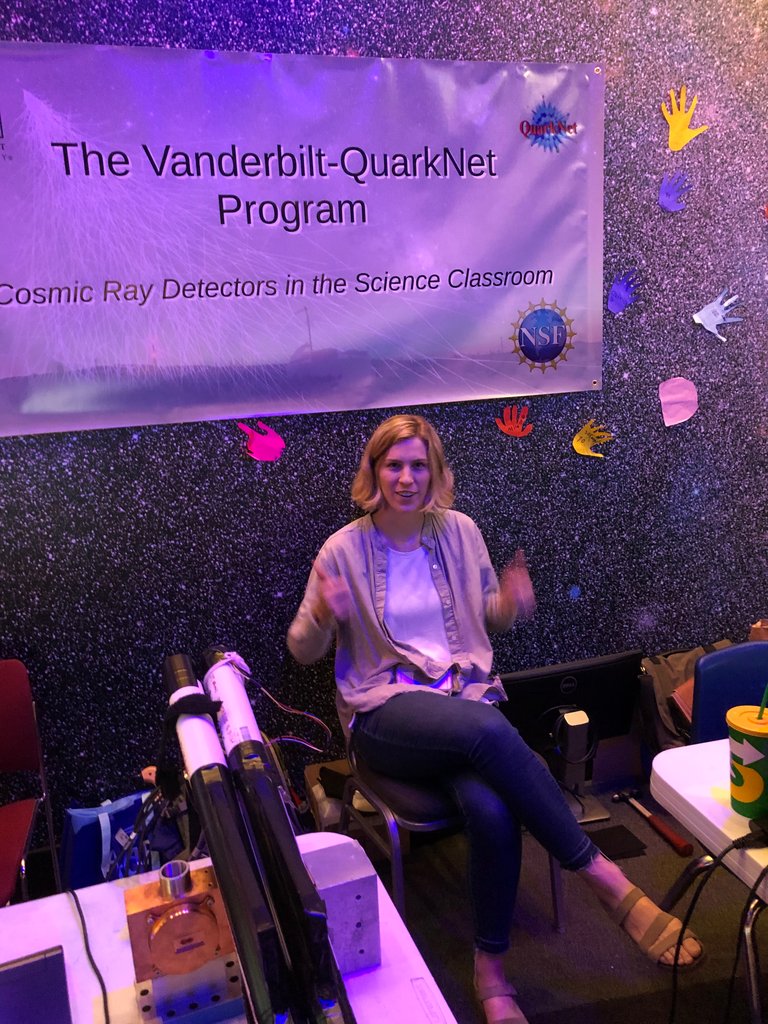Annual Report 2019 - Vanderbilt University
Vanderbilt University QuarkNet 2019
Personnel
The Vanderbilt University QuarkNET group is mentored by William (Bill) Gabella. Emeritus mentor Medford Webster has actually retired and moved to Colorado. We advise the teachers and students on the use of the Cosmic Ray Muon Detectors (CRMDs), we maintain them, and we help with either setup of our loaned out CRMDs or with those that are permanently at a school. We also host the 5 day summer workshop for the teachers.
Cosmic Ray Muon Detectors
The Vanderbilt QuarkNET has three "mentor" CRMDs: S/N 6181 and 6165 (replacing 6187 after DAQ card maintenance/replacement) are two conventional cosmic ray muon detectors and S/N 6925 (replacing 6769 after maintenance) is an "unconventional" one---it has smaller scintillator paddles. The one with the small scintillators is most useful for looking at attenuation of the muon flux with materials, like water, or bricks, stacked between pairs of scintillators. These are routinely loaned to our high school teachers for their club and classroom work. The laptops running the detectors are nearing 8 years old, so we are likely to seek newer ones. They are running the latest Fedora 30 which has some difficulty with the one with a NVida graphics card (the card is too old for this version of Linux). We also have several CRMDs that are permanently in the schools:
S/N 6851 in Bowling Green, KY, with Diana Gigante;
S/N 6850 in Nashville, TN, with James Anderson;
S/N 6891 in Mt. Juliet, TN, with Meaghan Berry;
S/N 6892 in Murfressboro, TN, with Kim Baumann; and
S/N 6795 in Cross Plains, TN, with Bill Hunnicutt.
We are using the Java program Equip for managing the CRMDs from the Fedora Linux laptops that we have. This works but there are several aspects of it that would be nice to have working and maintained. A facility to output a spreadsheet of the rise and fall times of complete pulses like the older LabVIEW program did would be helpful. WE use a custom fortran program for this utility. Perhaps eLab can do this.
For the GPS firmware update, we were able to use a Linux system running Wine to do the updates. The documentation from QuarkNet was very helpful, thanks! There was one fix of defining for Wine the USB port at COM1 otherwise it defaults to a high number and does not show up on the Windows update program. Successfully updated the GPS for our three in-house systems, for Hunnicutt's, Gigante's, and Baumann's GPS also. Replaced the 3.3V batteries as well. Sent off my three systems 6181, 6187, and 6769, the DAQ cards and GPS to Dave Hoppert for maintenance. Two of the cards showed incorrect voltage readbacks and an inability to calibrate the barometer. Dave was unable to fix two of the cards to his satisfaction and replaced them (see S/Ns above).
Summer Workshop 24-28 June 2019
The main activity of the Vanderbilt QuarkNet Group is hosting the five day workshop for current group members and new science teachers. It was attended by 10 teachers, 7 current group members and three new physics teachers from the Metropolitan Nashville Schools. The main focus this year was a QuarkNet, cosmic ray, and muon presentation at our local science museum, the Adventure Science Center for two days. As usually it included talks by Vanderbilt faculty and graduate students, and review of using the CRMDs and the eLab facilities for Cosmic Ray Muons.
The first day and a half had talks on the Compact Muon Solenoid (CMS), Vanderbilt University is a member of the collaboration, and the Large Hadron Collider. We heard from a graduate student about her particle physics research on CMS with a good particle physics introduction. Interestingly she folded in how her Christian religion motivates her love of science. Though at first I thought this might be awkward, not for many of my teachers. In rural Middle Tennessee, the teachers face the view that many students have that science is not commensurate with their faith...if you are a good Chrsitian you cannot be a scientist. These teachers thought it was useful to hear her prespective. We also had talks about the Relativistic Heavy Ion experiments at the LHC and at RHIC---Vanderiblt physicists belong to Phenix and SPhenix at RHIC and the CMS at the LHC. In our news reports section, we hear about the Event Horizon Telescope images of the supermassive black hole in M87. Other talks described LISA and Black Holes, the Pulsar Timing Arrays, especially Nanograv, and some status on the CMS detector during Long Shutdown 2.
After our summary of physics news and review of some topics, we focused our efforts on using the Cosmic Ray Muon Detectors and especially using them with eLab. To that end, we setup a standard CRMD in telescope configuration.
The rest of the second and all of the third day were spent planning for the outreach presentation at the Nashville Adventure Science Center. It was pointed out to the mentor that there are many visitors to the Center that are young children (under 10 years of age). So there was some new activities the teachers were able to come up with for the younger visitors. We also made a yeoman's effort to come up with small, working cloud chamber. Following many online guides, as well as YouTube presentations, we where unable to make on that worked well or consistently. This remains a bit of a mystery to the mentor. Even with more alcohol, adding heat to the top, with dry ice on the bottom no useful cloud showing particle tracks would form. Disappointing. Perhaps lack of patience for the supersaturated equilibrium that needs to take place.
The two days at the Adventure Science Center(ASC) were amazing and as good as we had hoped. With coordination with the ASC contacts, we were given a space large enough for three six foot tables of displays. We hung a banner behind us, with QuarkNet-Vanderiblt on it. We setup roughly in a linear arrangement by age. At one end were cartoons of particles and particle physics with Legos to be broken up by rubber balls and re-assembled as a metaphor for particle physics experiment/system/files/2019-06-28%2011.09.05b.jpgs, and the very popular draw your hand on a piece of paper with dots for the number of muons that pass through every minute. And for the patient children, they would count the number their hand shape enclosed and write their names and number on the paper and post it on a nearby column. In the middle we had a flat screen TV going with a 8 minute looped presentation on particle physics, cosmic rays, and cloud chambers. In front of it was a (non-working) cloud chamber...though the dry ice created fog was quite fascinating to the children. At the other end, we had a set of CRMDs running with a laptop displaying the EQUIP program, and an oscilloscope showing the signal from one of the PMTs. This was mostly of interest to adults and older children.

Adventure Science Center for outreach.

and Hand Drawing (muon per minute)

with an oscillosope and PMTs and scintillator plastic.
As follow-up, our teachers like very much to receive a letter of participation and we also send a certificate of participation. The letter describes the workshop activity well enough so the principal of the school can judge how much professional development credit the teachers should receive.
Links of Interest
Local web page http://www.hep.vanderbilt.edu/~gabellwe/qnweb
Facebook group page https://www.facebook.com/groups/682323215235912/
Vanderbilt QuarkNET Page (drupal, i.e. here) /group/vanderbilt-university-quarknet-center
[Written and edited by Bill Gabella 20191021]
